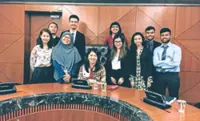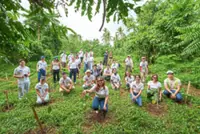Repurposing waste is an opportunity to innovate, reduce costs and create new revenue streams, fostering a sustainable future through collaboration and a circular mindset
THE pessimist sees difficulty in every opportunity, the optimist sees opportunity in every difficulty, Winston Churchill once said. This insight perfectly encapsulates the mindset shift needed in waste management.
While many view waste merely as a problem to be discarded, adopting an optimistic perspective reframes the challenge as an opportunity, a driver of economic growth—an untapped resource that can be repurposed, recycled and transformed into something valuable.
In Malaysia, businesses have the potential to convert waste heading to overflowing landfills into profitable resources. Through innovative practices like recycling, waste-to-energy solutions and upcycling, discarded materials such as plastics, paper and organic waste can be turned into valuable products.
Energy generated from waste incineration can be sold to the grid, creating a new revenue stream. With this shift in mindset, waste could evolve into a resource that fosters both environmental sustainability and economic growth.
However, it is important to recognise that waste cannot be wealth for everyone, and not all waste is capable of generating profit. If it were, there wouldn’t still be countless dumpsites across the country requiring significant funds for proper management.
Harmonising with the green shift
Besides being seen as a problem, waste is also often regarded as a cost. If a business is willing to leverage its existing network, waste can be collected from a site, repurposed or directed to recycling facilities, opening up the potential to generate revenue.
Waste Management Association of Malaysia (WMAM) executive committee technical chairman Zamri Abdul Rahman and its technical and research committee co-chair Low King Hserng states that shifting from seeing waste as a burden to
recognising it as a valuable resource requires businesses and individuals to adopt a circular mindset, driven by innovation, collaboration and a commitment to sustainability.
“Embracing circular economy principles enables businesses to rethink their models to ensure waste is integrated into their production processes. Businesses can turn waste into opportunities by embracing circular economy principles and integrating waste into their production processes,” says Zamri.
“By prioritising reusable and repurposable materials, companies can drive sustainability. For example, IKEA’s Buy-Back Programme resells or refurbishes old furniture, while Dell transforms old
electronics into new products through its e-waste recycling programme, generating value from waste,” says Low.
They highlight that shifting from a traditional approach to a circular economy also involves designing products with recyclability and reusability in mind. For example, the CAREton Project, a collaboration between Tetra Pak—which actively
promotes food packaging recycling and other sustainable initiatives—and Nestlé Malaysia, has collected over 4,700 tonnes of used beverage cartons since 2012.
The materials were then recycled into roofing tiles and panel boards to support housing projects for Malaysia’s Orang Asli communities.
“Collaborations with researchers or waste management firms can also lead to innovative solutions. Petronas’ circular plastic initiative, which repurposes plastic waste into high-value resin, exemplifies how cross-industry partnerships can drive progress,” says Zamri.
Low adds that on an individual level, adopting a zero-waste lifestyle is key to shifting one’s mindset. “Viewing waste as a resource opens up possibilities—used
coffee grounds can be composted and orange peels can become natural cleaning solutions.
“Everyday actions, like upcycling glass jars or repairing clothes, reduce waste. Supporting businesses that promote sustainability, like Patagonia’s focus on reselling and repairing apparel, or Nike Grind’s transformation of old shoes into sports surfaces, further encourages a circular economy,” says Low.
Both emphasise while it is imperative that waste repurposing must balance environmental responsibility with financial viability, companies can integrate waste-to-value strategies while maintaining profitability.
Hurdles to hurtle
Despite its environmental and economic benefits, many businesses are reluctant to adopt waste repurposing due to key challenges. Zamri and Low cite the high initial investment costs for recycling or upcycling infrastructure and limited awareness and expertise hinder progress.
“Complex regulations and certification requirements make waste repurposing a resource-intensive endeavour. The low demand for recycled materials further reduces financial incentives, and modifying production processes can disrupt operations.
“In Malaysia, scaling up WTE and upcycling initiatives faces similar obstacles. However, strategic solutions, such as
public-private partnerships, green financing, and carbon credit incentives, can mitigate financial risks,” says Low.
Zamri says: “Regulatory barriers and inconsistent waste management policies also impede progress, but implementing Extended Producer Responsibility (EPR) laws and tax incentives for renewable WTE electricity can encourage industry participation.
“Improving waste collection and sorting remains challenging due to unsegregated municipal waste and limited infrastructure. Consumer acceptance of upcycled products and WTE energy is also a barrier, as some perceive recycled materials as inferior.”
Noting that collaboration between industries is essential but often lacking, Low says regional cooperation, industrial symbiosis programmes and increased research and development funding for green technologies drive innovation and foster a circular economy.
However, Low shares that Adidas, a global leader in the sportswear industry, has demonstrated that these challenges can be overcome. In 2015, it recognised the need for circular solutions but faced high costs and limited recycling technologies. By 2019, the company joined the Sorting for Circularity initiative, improving waste collection and aligning its operations with emerging recycling methods.
In 2022, it partnered with 13 stakeholders to launch Textile Recycling Excellence (T-REX), developing a standardised framework to address regulatory and market barriers in textile waste recycling.
Today, Adidas continues to refine its
circular strategy, investing in advanced recycling technologies, expanding collaborations, and advocating for policy changes to support large-scale waste repurposing.
Homegrown practices
Malaysian businesses are increasingly adopting waste-to-energy (WTE), material recovery and upcycling practices to boost sustainability and align with ESG leadership and the circular economy. Low shares that there are notable projects across the country which highlight how waste is being transformed into valuable resources, contributing to Malaysia’s broader sustainability objectives.
One notable initiative is the Bukit Tagar EnviroPark’s Landfill Gas-to-Energy Project, which captures methane from decomposing waste to generate 12MW of renewable electricity, reducing greenhouse gas emissions and contributing to Malaysia’s renewable energy mix.
Similarly, the Seelong Landfill Gas-to-Energy Project in Johor utilises landfill methane to produce energy, improving waste management efficiency and minimising environmental impact.
Companies such as Worldwide Holdings, KDEB Waste Management with YTL Power, and Malakoff are also developing advanced WTE plants across Malaysia to convert municipal solid waste (MSW) into heat and electricity, further supporting the country’s transition to sustainable energy.
In material recovery and recycling, E-Idaman pioneered Malaysia’s first Drive-Thru Recycle Centre, promoting the 3Rs (Reduce, Reuse, Recycle) within communities. Alam Flora’s Fasiliti Inovasi Kitar Semula (FIKS) and SWM Environment’s KITARecycle programme also encourage public engagement with recycling.
Heng Hiap Industries recycles discarded plastics into high-quality resins for global export, while Pentas Flora refines used motor oil into alternative fuels, reducing environmental pollution while generating economic value. These companies leverage advanced technologies to reduce plastic pollution and support the circular economy.
In the agricultural sector, FGV Holdings Bhd repurposes palm oil by-products into bioenergy and biodegradable products, reducing waste and generating alternative revenue streams.
Life Line Clothing Malaysia addresses textile waste by repurposing post-consumer fabrics into industrial rags, insulation, and upcycled fashion, promoting circularity in the fashion industry.
Underutilised potential
Malaysia generates a substantial volume of industrial and agricultural by-products, many of which offer significant potential for reuse and resource recovery. As one of the world’s largest palm oil producers, Malaysia generates millions of tonnes of mill effluent, empty fruit bunches and palm kernel shells annually.
“Rather than being discarded, these by-products can be repurposed into renewable energy sources such as biogas, biochar and biomass pellets. Similarly, rice husks, an abundant by-product of the rice milling industry, can be processed into silica for industrial use, bio-based construction materials and biofuels, reducing waste, while creating valuable new applications.
“Food waste, another pressing issue, also presents opportunities for innovation. For example, spent coffee grounds contain antioxidants, oils and fibres that can be repurposed into cosmetics, biofuels, and even animal feed,” says Low.
Zamri adds that start-ups around the world have successfully transformed coffee waste into skincare products and functional food additives. “Likewise, fruit peels from durians, bananas and pineapples can be used to create biodegradable packaging, natural dyes and dietary fibre supplements, offering sustainable alternatives to conventional materials.
“With the rise of fast fashion, textile waste in Malaysia is increasing, yet it holds immense potential for reuse. Shredded cotton and polyester fabric waste can be repurposed into thermal and acoustic insulation panels for buildings and vehicles, while discarded textiles can be upcycled into new garments, bags and accessories.”
He adds that fabric scraps can also be used for industrial rags, cleaning cloths, mattress padding and upholstery fillings, providing durable and cost-effective alternatives to synthetic materials. Advanced chemical recycling technologies can further break down polyester waste into high-quality reusable fibres, promoting a circular textile economy and reducing waste within the industry.
Meanwhile, e-waste from outdated smartphones, laptops, home appliances, and electric vehicle (EV) batteries is growing rapidly as Malaysia’s technology sector expands. These discarded electronics contain valuable materials such as lithium, cobalt, nickel and rare earth elements, essential for manufacturing new batteries, circuit boards and high-tech components.
“However, much of this e-waste remains underutilised due to limited recycling infrastructure and awareness. Expanding e-waste collection networks, introducing incentives for take-back programmes, and investing in advanced recycling technologies can help recover these valuable materials to turn them into a significant economic opportunity while fostering a circular economy,” says Low.
Cultivating a competitive edge
In August 2024, the Housing and Local Government (KPKT) Minister launched the Circular Economy Blueprint for Solid Waste in Malaysia (2025-2035). This initiative aims to enhance the value of materials by extending product life through eco-friendly design and recycling practices, ultimately closing the loop in the waste sector. The blueprint outlines a clear direction for the development of the national circular economy, including the implementation of Extended Producer Responsibility and zero-waste-to-landfill certification for manufacturers.
Other key ministries, such as the Investment, Trade and Industry Ministry, the Natural Resources and Environmental Sustainability Ministry as well as the Economic Affairs Ministry, play essential roles in shaping policies and frameworks that steer the nation towards a circular economy.
Zamri and Low emphasise that policymakers play a crucial role in making sustainability more accessible. By simplifying regulations and streamlining permitting processes, they can facilitate the successful WTE implementation and upcycling projects. Offering tax incentives and subsidies further encourages businesses to invest in circular economy initiatives, while fostering regional cooperation can optimise waste management across industries and borders.
On the business side of things, advancements in technology are transforming waste management, unlocking the hidden value of waste and improving efficiency. “Smart systems, powered by Internet of Things sensors, real-time data analytics, and automation, are streamlining collection, reducing environmental impact and lowering operational costs.
“WTE technologies, such as mass burn incineration, can reduce waste volume by up to 90%, generating heat and electricity while cutting reliance on landfills. Anaerobic digestion processes organic waste into renewable biomethane and liquid fertiliser, offering an eco-friendly solution for organic waste,” says Low.
Zamri shares that projects like CopenHill and Solrød Bioenergy in Copenhagen highlight how cities can reduce landfill dependence and produce clean energy. “Artificial Intelligence (AI) and automation are also revolutionising the sector, with AI-powered sorting systems enhancing recycling efficiency, reducing contamination and improving resource recovery. These technologies also help analyse waste trends, optimise collection and allocate resources more effectively,” he says.
All in all, repurposing waste offers businesses the chance to innovate, reduce costs and create new revenue streams, turning waste into a competitive advantage. Through waste-to-value strategies, technology, a circular mindset and with collaboration across industries, policymakers and consumers, a sustainable future is achievable.







